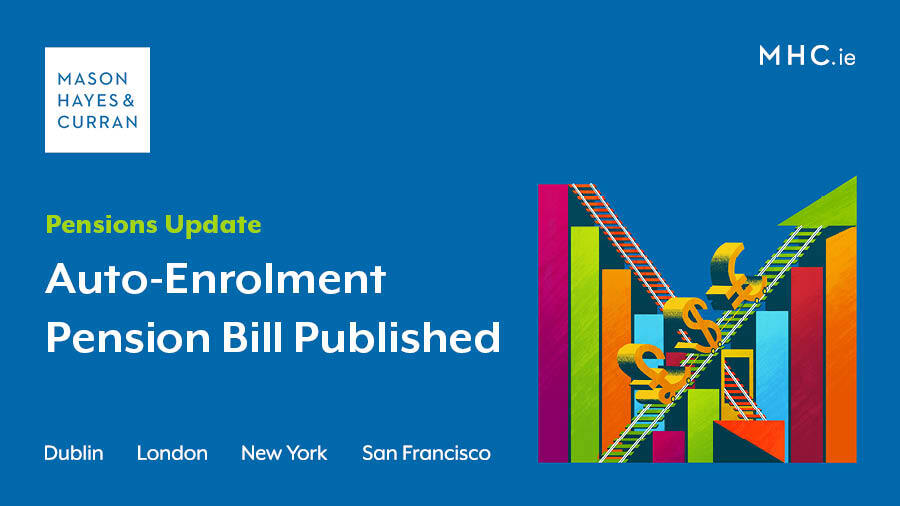Auto-Enrolment Pension Bill Published

The Irish Government recently published the Bill necessary to establish the auto-enrolment pension system for employees not already covered by qualifying pension arrangements. Our Pensions team reviews this Bill, its key elements if it passes as currently drafted and what organisations need to do next.
“Auto-enrolment” is the word of the day for pension experts and Ireland’s wider business community. While it has been mooted for many years, now it is finally within sight. The Government published the Automatic Enrolment Retirement Savings System Bill 2024 at the end of March. The Minister for Social Protection is adamant that the system will be implemented by the end of this calendar year. However, in addition to debating and passing the Bill, much remains to be done to implement the technical, administrative, and organisational measures necessary to establish the system.
Governing auto-enrolment
Perhaps the most significant element of the Bill is the proposed establishment of a statutory authority to establish, maintain and control the auto-enrolment system. The National Automatic Enrolment Retirement Savings Authority will be charged with arranging for the enrolment, collection of contributions, and establishment and maintenance of retirement savings accounts. It will also be responsible for:
- The provision of related information and services
- The investment of contributions with investment management providers
- Facilitating the payment of retirement savings
- Monitoring and enforcing compliance, and
- Undertaking research relating to retirement savings services
The National Automatic Enrolment Retirement Savings Authority will be supervised by the Pensions Authority.
How does it work?
A person will be automatically enrolled in the system if they are an employee and are:
- Between the ages of 23 and 60,
- Not already a member of a qualifying pension plan, and
- In receipt of total gross pay in all employments of at least €20,000 per annum
The Bill proposes three sources of contribution, paid as a percentage of an employee’s gross pay, as follows:
Source |
Years 1-3 |
Years 4-6 |
Years 7-9 |
Years 9+ |
Participant |
1.5% |
3% |
4.5% |
6% |
Employer |
1.5% |
3% |
4.5% |
6% |
State |
0.5% |
1% |
1.5% |
2% |
Contributions must only be made on the first €80,000 of a participant’s gross pay, although the Minister may amend this through subsequent related regulations. The Bill also sets out the conditions for opting in and out of the auto-enrolment system.
Once contributions are made and invested by the National Automatic Enrolment Retirement Savings Authority on behalf of participants, they can be paid out on reaching the State pension age, on death, or earlier in the event of incapacity or exceptional ill health.
We note that the Bill provides for the implementation of standards within future regulations. If implemented, these would essentially aim to ensure minimum standards as between the auto-enrolment savings system and other pension schemes, PRSAs and trust RACs. These standards would come into effect sometime within the first seven years of the auto-enrolment phasing-in period.
Compliance and enforcement
It is proposed that the National Automatic Enrolment Retirement Savings Authority will have a range of inspection and enforcement powers, including the power to issue compliance and fixed-penalty notices. A range of new offences have also been created, including:
Offence |
Penalty |
Failure of an employer to give notice of the determination and enrolment date in the system to an employee |
Class A fine, imprisonment for up to 6 months, or both on summary conviction |
Hindering an employee from participating in the system |
As above |
Failure of an employer to pay contributions to the system on behalf of an employee |
As above |
Obstructing or not cooperating with an authorised officer of the Authority |
Ditto on summary conviction; a fine not exceeding €50,000, imprisonment for up to 3 years, or both on conviction on indictment |
Failing to comply with a compliance notice by the date specified |
As above |
Forging a notice, certificate or other document purporting to be issued, granted or given |
As above |
Comment
The Bill’s aim is laudable and, if implemented, could provide for a pension system for an estimated 800,000 people currently working in Ireland without any provision for retirement. However, there is little time for substantial debate on the provisions of the Bill if it is to be passed and implemented before the end of 2024. Even if this does occur, however, the compliance pressures on employers and those providing funds into which the contributions will be invested will be intense. As with any initiative, a wide range of challenging legal and practical teething issues should be expected. Employers now need to be seriously considering the implications for their businesses.
For more information and expert advice on how auto-enrolment will materially impact your business’s operations, contact a member of our Pensions team.
People also ask
What is auto-enrolment? |
Auto-enrolment is an automatic retirement savings system that requires contributions from employers, employees, and the State, so that those currently without a pension will be provided for when they retire. |
When will auto-enrolment be introduced? |
Although the Bill was published in late March 2024, the Government of Ireland is adamant that the auto-enrolment system will be fully implemented by 1 January 2025. |
What are the key features of the auto-enrolment system? |
The operation of the system will be managed and implemented by a new statutory authority which will be charged with arranging for the enrolment, collection of contributions, establishment and maintenance of retirement savings accounts and the provision of related information and services, the investment of contributions with investment management providers, facilitating the payment of retirement savings, monitoring and enforcing compliance and undertaking research relating to retirement savings services. The Bill provides a comprehensive legislative basis for all of these elements of the system. |
What sort of control will participants in the system have over their contributions? |
Contributing participants will be able to invest in investment funds that are either low-, medium- or high-risk. By default, they can only contribute to funds at one of these risk levels, not several. Nonetheless, contributions will be split equally between investment management providers where there is more than one provider. |
Is everyone eligible for auto-enrolment? |
No. However, while most people without a pension will be eligible, others can opt in. |
The content of this article is provided for information purposes only and does not constitute legal or other advice.
Share this:




